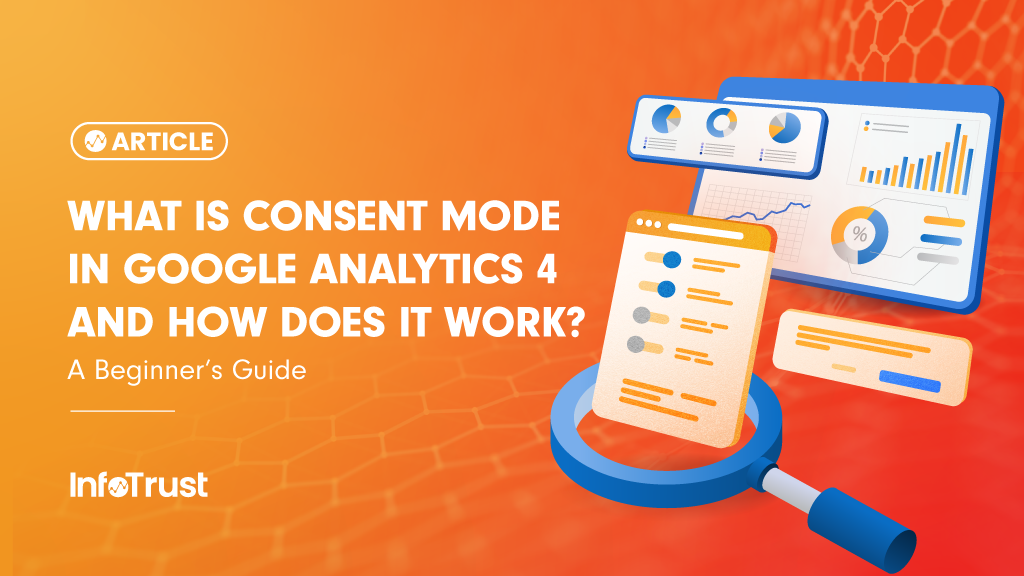Consent Mode in Google Analytics 4 (GA4) is a helpful tool for website owners to respect user privacy preferences when it comes to tracking and collecting data. It lets you customize how GA4 collects and processes data based on what users consent to. Consent Mode is valuable for maintaining user privacy, giving you more granular control over Google Analytics features like user ID and audience creation for personalized advertising. This is particularly beneficial for websites seeking to maximize the utilization of first-party data while upholding the privacy rights of users. They must comply with privacy laws and uphold transparency regarding their data practices in order to optimize the usage of first-party data while respecting the privacy rights of users. In simple terms, Consent Mode helps websites responsibly manage cookies and user data.
How Consent Mode Works
Consent Mode isn’t managing the consent experience—it is “translating” the consent selection as made via the Consent Management Platform into a format usable by Google tags. From there, the Google tags will modify their behavior according to the settings communicated via Consent Mode.
Benefits of Consent Mode
- Compliance with privacy regulations – Consent Mode aids in compliance with regulations like GDPR and CCPA, which require user consent for data collection.
- Transparency and trust – Users appreciate when businesses respect their privacy. Consent Mode builds trust by giving them control over their data.
- Data accuracy – Consent Mode enables modeling in GA4 to fill the measurement gap resulting from not all users granting consent for deterministic behavioral tracking.
Check If Google Analytics Is Receiving Consent Signals
To ensure compliance with Google Analytics policies on ads measurement and personalization consent, it’s important to confirm that your website or app is obtaining proper user consent. Google Analytics requires specific consent parameters for ads measurement (ad_user_data) and ads personalization (ad_personalization). Obtaining affirmative consent signals from users is essential, particularly for personalized advertising and remarketing. Review the data streams within your GA4 properties to verify if these required consent signals are being sent.
Check the list of data streams in each of your GA4 properties to learn if you are sending the required consent signals:
Navigate to Admin:
- Log in to your Google Analytics account and access your desired GA4 property.
- Click on “Admin” in the bottom left corner of the navigation menu.
Locate Data Streams:
- Within the Admin section, navigate to “Data collection.”
- Under “Data collection,” select “Data streams.”
Identify Streams with Missing Signals:
- In the list of data streams, look for any entries with an “Action required” label next to them. This indicates potential issues with consent signal reception.
Review Consent Settings:
- Click on a data stream with the “Action required” label.
- Within the data stream settings, locate the section labeled “Consent settings.” This section might have subsections related to:
- Ads measurement consent signals
- Personalization consent signals
- Managing data use across Google services
Interpret Consent Status:
- If any of the subsections within “Consent settings” display an “Action required” label, it means GA4 isn’t receiving the necessary consent signals for that specific area.
- If all subsections appear clear without “Action required” labels, then GA4 is likely receiving the appropriate consent signals for that data stream.
Additional Tips:
- Understanding the Signal: The specific consent signal missing will depend on your configuration and the type of data you’re collecting. The subsections within “Consent settings” should provide clues about what’s missing.
- Resolving Issues: Once you identify the missing consent signal, you’ll need to adjust your website or app implementation to send the correct signals to GA4.
- Data Processing Delay: Keep in mind that there might be a delay of up to 48 hours after you update your website or app for GA4 to start reflecting the new consent signals.
Conclusion
Enabling Consent Mode in GA4 helps enhance user privacy and support compliance with data protection regulations. By following this beginner’s guide, you can seamlessly integrate Consent Mode into your GA4 property, fostering transparency and trust with your audience while respecting their privacy choices.


